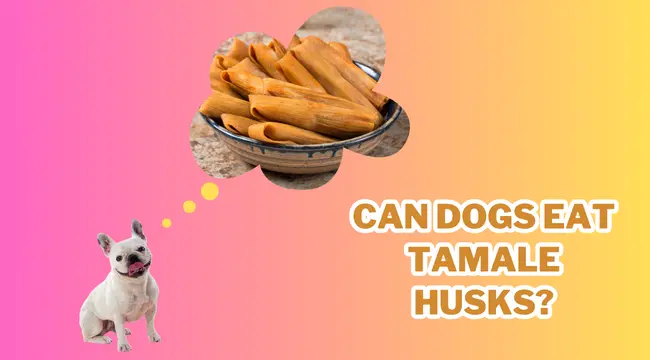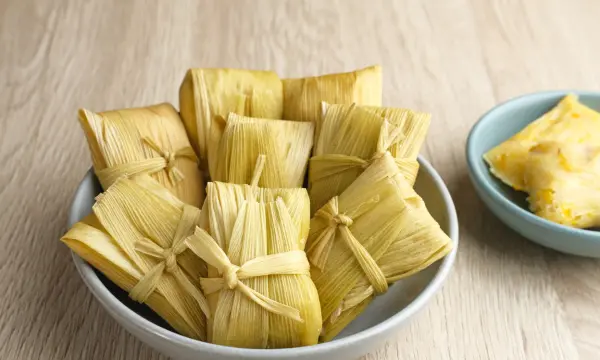
Imagine you’re sitting down to enjoy a delicious tamale, the kind wrapped in a corn husk that smells just as good as it tastes. It’s a dish with deep roots in tradition, loved by many for its warm, comforting flavors. Now, picture your furry best friend sitting beside you, giving you those big, pleading eyes. They want a bite, but a question pops into your head: Is it safe for dogs to eat tamale husks?
It’s natural to want to share a bit of your meal with your pup. It feels like a way to show love and make them feel part of the family fun. But, the reality is, not everything we eat is good for our dogs. This guide is all about tamale husks and whether they belong in your dog’s diet. We’re going to cover the need-to-knows, from health risks to nutritional no-gos, aiming to keep mealtime safe and enjoyable for everyone at the table—including those with four legs.
What Are Tamale Husks?

Imagine wrapping a gift, but instead of paper, you’re using natural materials like corn husks or banana leaves. That’s exactly what tamale husks are in the culinary world—a natural wrapper for the delicious masa (a dough made from cornmeal) and filling that make up a tamale. These wrappers aren’t just for show; they keep everything together during cooking and add a subtle flavor that’s part of the tamale’s charm. However, they’re not meant to be eaten, serving more as a cooking and presentation tool than an ingredient.
Can Dogs Eat Tamale Husks?
It’s not safe for dogs to eat tamale husks. While these natural wrappers are an essential part of making tamales, they pose several risks to dogs if ingested. Tamale husks can be a choking hazard, especially for dogs that tend to eat quickly or don’t chew their food thoroughly. Additionally, because dogs can’t properly digest these materials, there’s a risk of gastrointestinal blockage, which can be serious and may require veterinary intervention. There’s also the potential for allergic reactions to the husks themselves or to residues of spices and ingredients on them, which could be harmful to your pet.
Instead of sharing tamale husks with your dog, it’s better to opt for safer, dog-friendly treats that provide nutritional value and are specifically designed for canine consumption. Always keep an eye on your furry friend during meal times to prevent access to unsafe foods, and know the signs of distress to watch for if they do ingest something they shouldn’t. When in doubt, consult your veterinarian for the best advice on keeping your dog safe and healthy.
Related Post: Can Dogs Eat Tamale?
The Risks of Feeding Tamale Husks to Dogs
When it comes to our canine friends, what’s harmless for humans can sometimes be risky for them. Here’s why tamale husks might not be the best treat for your dog:
- Choking Hazard: Dogs, especially the eager eaters or the smaller breeds, might not chew the husks properly. These husks can then become a choking risk, potentially blocking their airway.
- Digestive Blockage: Unlike some foods that can be digested easily, corn husks are tough and can end up causing blockages in a dog’s digestive tract. This is especially true for materials like banana leaves or corn husks, which don’t break down easily in a dog’s stomach.
- Allergic Reactions and Sensitivities: Just like people, dogs can have allergies. Some might react poorly to tamale husks, showing symptoms like itching, swelling, or gastrointestinal upset. Plus, the spices and seasonings that might cling to these husks are not always dog-friendly.
Nutritional Concerns
When we think about nutrition for dogs, tamale husks offer, well, pretty much zilch. They don’t provide any nutritional value that dogs need and can’t replace any part of a balanced diet. In fact, there are much better sources of dietary fiber out there that are safe and beneficial for dogs, like pumpkin or sweet potato, which are not only digestible but also packed with vitamins.
Safe Alternatives to Tamale Husks for Dogs
So, what can you share with your pup during tamale night? Plenty! Instead of risky tamale husks, opt for dog-friendly veggies like carrots or cucumbers as a crunchy treat. Or consider specially made dog treats that are designed to be both nutritious and delicious. The key is to keep your dog’s diet balanced and suited to their specific health needs, which means treats should only be a small part of what they eat. Always keep fresh, clean water available, and consult with your vet if you’re thinking of making any big changes to what your dog eats.
How to Respond If Your Dog Eats a Tamale Husk
Even with the best precautions, dogs can be quick and sneaky, sometimes eating things they shouldn’t. If you catch your dog chomping on a tamale husk, here’s what you should do:
- Don’t Panic: Keep a close eye on them for any immediate signs of choking or distress.
- Remove Any Remaining Husks: Ensure no more husks are within reach to prevent further ingestion.
- Observe Your Dog: Look for signs of discomfort, unusual behavior, or distress, including vomiting, lethargy, or difficulty going to the bathroom.
When to Contact a Veterinarian
If you notice any of the following symptoms, it’s time to call your vet:
- Persistent vomiting or gagging
- Signs of abdominal pain or discomfort
- Difficulty defecating or signs of a blockage
- Any kind of distress or unusual behavior
Your vet can give you advice over the phone or recommend bringing your dog in for a check-up, depending on the symptoms.
Preventing Unsupervised Access to Unsafe Foods
Keeping your dog safe means preventing access to foods that could be harmful. Here are a few strategies:
- Use Pet-Proof Containers: Store food in containers with secure lids or in places your dog can’t reach.
- Training: Teach commands like “leave it” to stop your dog from eating something harmful.
- Supervision: Keep an eye on your dog during family meals or gatherings, ensuring they can’t sneak a bite of something dangerous.
Conclusion
In the world of dog-friendly foods, tamale husks are a no-go. They pose risks like choking, digestive blockage, and potential allergic reactions without offering any nutritional benefits. While it’s tempting to share our favorite foods with our furry friends, their safety and health come first. Opt for safer, nutritious treats and always keep an eye on your pup during meal times to prevent any unsupervised snacking on dangerous items.
FAQs
Can dogs digest corn husks? No, dogs can’t properly digest corn husks. These can lead to digestive blockages, making them unsafe for dogs to eat.
Are there any safe parts of a tamale for dogs? The cooked filling of a tamale might be safe for dogs, but it depends on the ingredients. Avoid any fillings with onions, garlic, or excessive spices. When in doubt, stick to dog-specific treats.
How can I know if my dog is allergic to something in tamales? Watch for signs of an allergic reaction after your dog eats something new, including itching, swelling, or gastrointestinal upset. If you suspect an allergy, consult your veterinarian for advice.



